Cleaning a burnt pot or pan can be a frustrating task, but it’s a necessary one if you want to keep your cookware in good condition. Whether you left your pot on the stove for too long or accidentally burned your food, there are several methods you can use to clean it up. In this article, I will share some tips and tricks to help you clean a burnt pot or pan effectively.
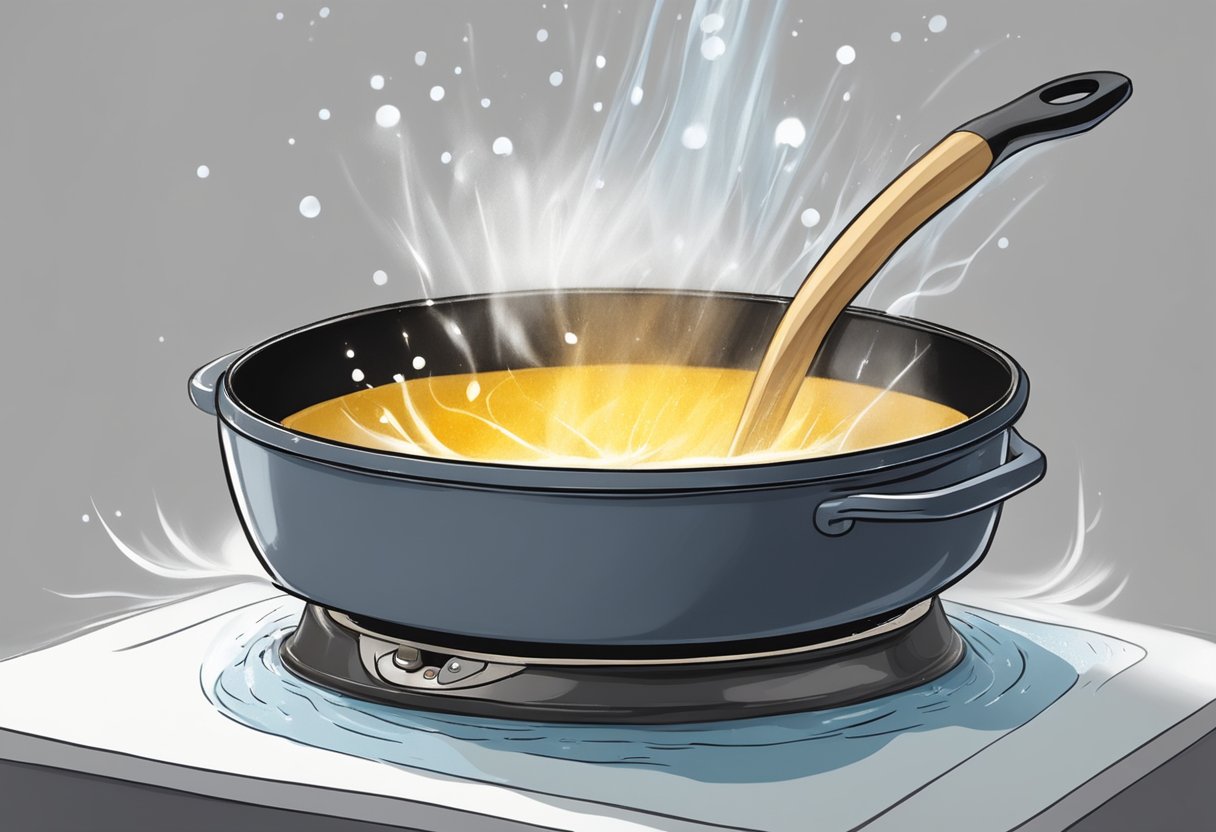
Before we get into the cleaning methods, it’s important to understand the material of your pot or pan. Different materials require different cleaning methods, and using the wrong technique can damage your cookware. For example, non-stick pans should not be cleaned with abrasive materials like steel wool, as this can scratch the surface and ruin the non-stick coating. Cast iron pans, on the other hand, require a different cleaning process altogether. By understanding the material of your pot or pan, you can choose the best cleaning method for your cookware and prevent further damage.
Key Takeaways
- Understanding the material of your pot or pan is crucial for choosing the right cleaning method.
- Basic cleaning methods like soaking and scrubbing can be effective for removing burnt-on food.
- Safe and natural alternatives like baking soda and vinegar can be used to clean burnt pots and pans.
Understanding the Material of Your Pot or Pan
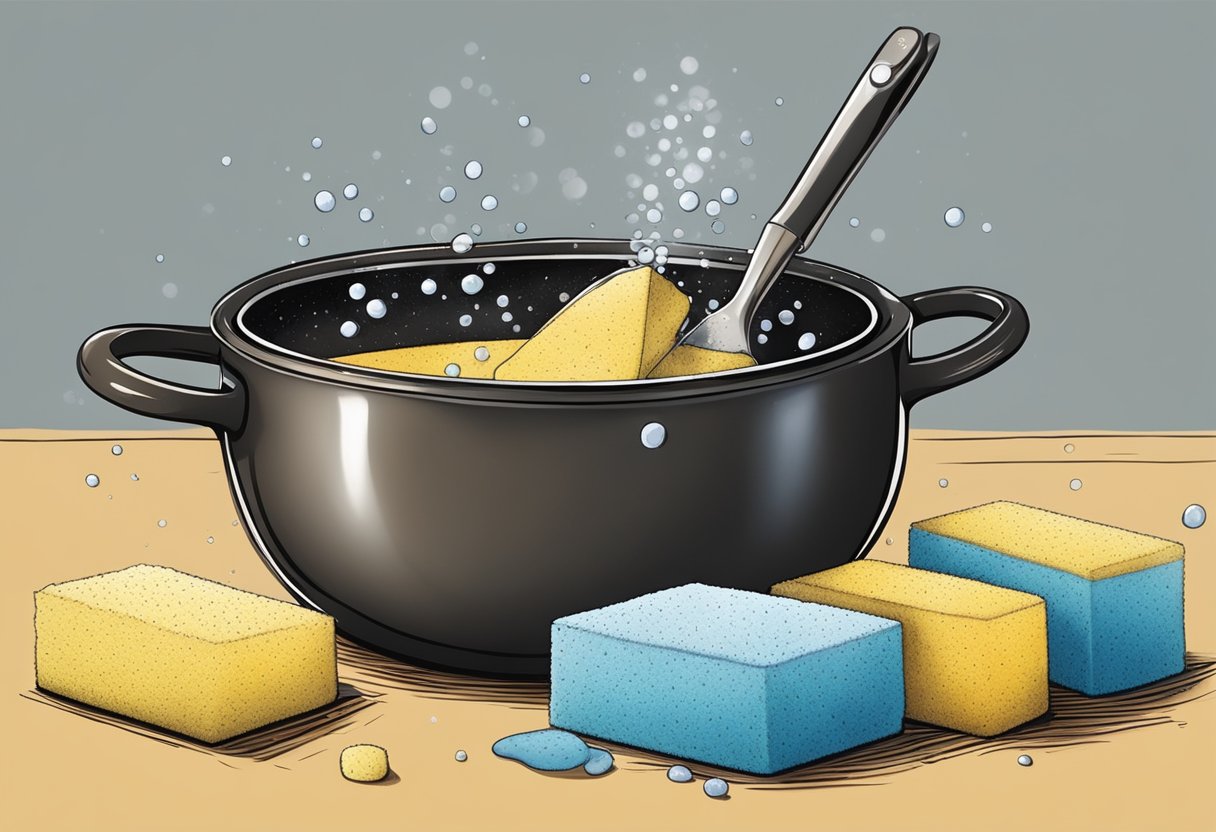
When it comes to cleaning a burnt pot or pan, it’s important to understand the material of your cookware. Different materials require different cleaning methods to avoid damaging the surface. Here are some common materials and how to clean them:
Stainless Steel
Stainless steel is a popular material for cookware due to its durability and resistance to rust and staining. To clean a burnt stainless steel pot or pan, start by adding hot water and dish soap to the pot or pan. Let it soak for a few minutes before scrubbing with a non-abrasive sponge or brush. For tougher stains, you can use a mixture of baking soda and water to create a paste and apply it to the burnt area. Rinse with hot water and dry with a towel.
Aluminum
Aluminum is a lightweight material that heats up quickly and evenly. However, it’s also prone to scratching and staining. To clean a burnt aluminum pot or pan, start by adding hot water and dish soap to the pot or pan. Let it soak for a few minutes before scrubbing with a non-abrasive sponge or brush. For tougher stains, you can use a mixture of cream of tartar and water to create a paste and apply it to the burnt area. Rinse with hot water and dry with a towel.
Cast Iron
Cast iron is a durable material that retains heat well and can be used on any cooking surface. However, it requires special care to avoid rusting and damaging the seasoning. To clean a burnt cast iron pot or pan, start by adding hot water and kosher salt to the pot or pan. Let it soak for a few minutes before scrubbing with a non-abrasive sponge or brush. For tougher stains, you can use a mixture of baking soda and water to create a paste and apply it to the burnt area. Rinse with hot water and dry with a towel.
Copper
Copper is a beautiful material that heats up quickly and evenly. However, it requires special care to avoid tarnishing and discoloration. To clean a burnt copper pot or pan, start by adding hot water and dish soap to the pot or pan. Let it soak for a few minutes before scrubbing with a non-abrasive sponge or brush. For tougher stains, you can use a mixture of lemon juice and salt to create a paste and apply it to the burnt area. Rinse with hot water and dry with a towel.
Polycarbonate
Polycarbonate is a lightweight and shatterproof material that is often used for non-stick cookware. However, it’s not as durable as other materials and can scratch easily. To clean a burnt polycarbonate pot or pan, start by adding hot water and dish soap to the pot or pan. Let it soak for a few minutes before scrubbing with a non-abrasive sponge or brush. Avoid using abrasive cleaners or scrubbers that can scratch the surface. Rinse with hot water and dry with a towel.
Preventing Further Damage
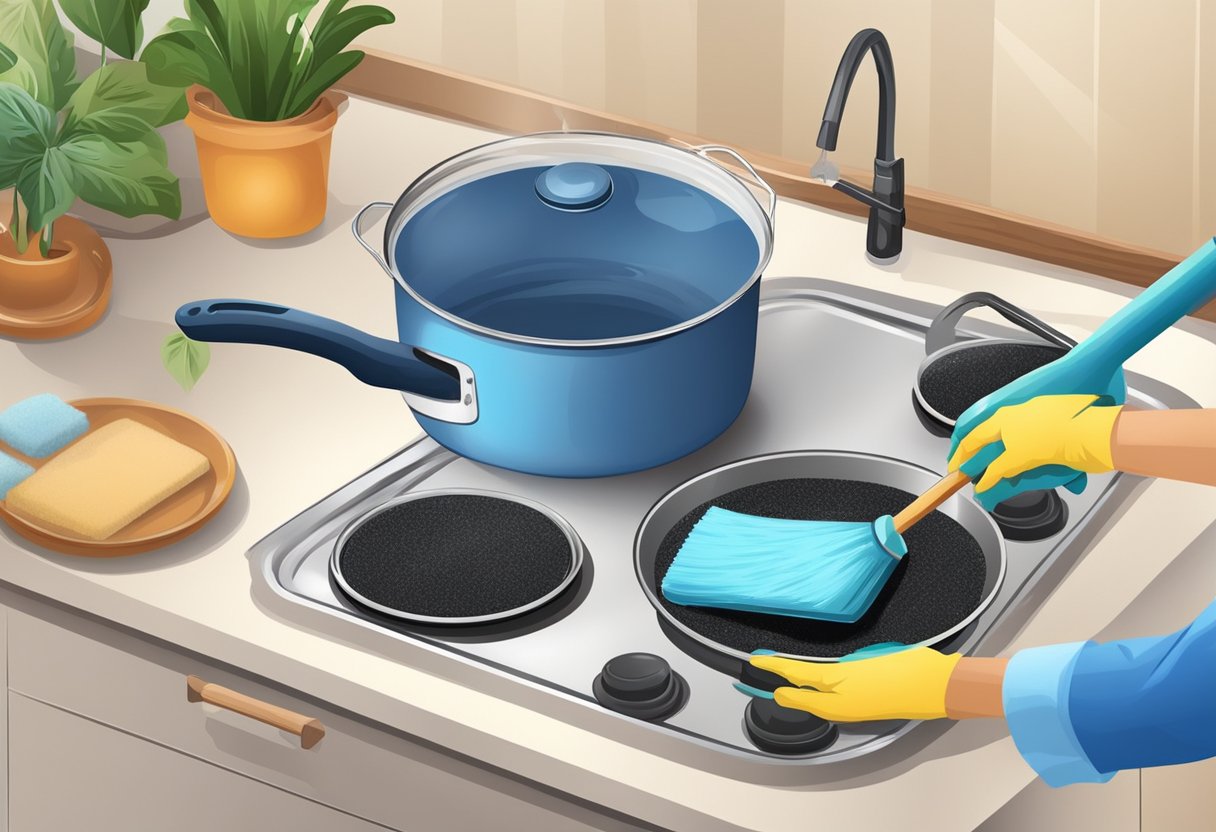
When it comes to cleaning a burnt pot or pan, prevention is always better than cure. Here are some tips to prevent further damage to your cookware:
- Use the right heat setting: Make sure you are using the right heat setting for the type of cookware you are using. High heat can cause discoloration, warping, and even melting of the cookware.
- Use the right utensils: Avoid using metal utensils on non-stick cookware, as this can cause scratches and damage to the surface. Instead, use silicone, wooden, or plastic utensils.
- Be careful with acidic foods: Acidic foods like tomatoes, vinegar, and citrus can cause discoloration and even damage to some types of cookware. If you are cooking with acidic foods, use stainless steel or ceramic cookware.
- Don’t leave food in the pot or pan: Leaving food in a pot or pan for too long can cause burns and stains that are difficult to remove. Make sure to clean your cookware as soon as possible after use.
- Use the right cleaning method: Different types of cookware require different cleaning methods. Make sure to use the right method for your cookware to avoid further damage.
By following these tips, you can prevent further damage to your cookware and avoid the need for deep cleaning or replacement.
Basic Cleaning Methods
https://www.youtube.com/watch?v=mrQ_ONExch4&embed=true
When it comes to cleaning a burnt pot or pan, there are several methods you can use to get rid of the stubborn burnt-on food. Here are some basic cleaning methods that you can try:
Soaking Method
One of the easiest ways to clean a burnt pot or pan is to soak it in hot water and dish soap. Fill the pot or pan with hot water and a few drops of dish soap, and let it soak for a few hours or overnight. This will help soften the burnt-on food and make it easier to scrub off.
Scrubbing Method
If soaking doesn’t work, you can try scrubbing the burnt-on food off with a scouring pad or steel wool. Be careful not to scratch the surface of the pot or pan. You can also use a spatula or nylon brush to scrape off any remaining burnt-on food.
Deglazing Method
The deglazing method involves adding water to the pot or pan and heating it on the stovetop to loosen the burnt-on food. Once the water starts to boil, use a spatula or wooden spoon to scrape off any remaining burnt-on food.
Dishwasher Method
If your pot or pan is dishwasher-safe, you can try using your dishwasher to clean it. Add a dishwasher tablet or a tablespoon of dishwasher detergent to the pot or pan, and fill it with a few inches of hot water. Place it in the dishwasher and run a normal cycle.
Baking Soda Method
Baking soda is a natural abrasive that can help remove burnt-on food from pots and pans. Make a paste by mixing baking soda and water, and use a sponge or scrub brush to apply it to the burnt areas. Let it sit for a few minutes, then rinse with hot water.
Vinegar Method
Vinegar is another natural cleaning agent that can help remove burnt-on food. Fill the pot or pan with equal parts water and white vinegar, and bring it to a boil. Let it simmer for a few minutes, then use a spatula or nylon brush to scrape off any remaining burnt-on food.
Salt Method
Salt is a gentle abrasive that can help remove burnt-on food from cast iron pots and pans. Sprinkle a generous amount of salt onto the burnt areas, and use a damp sponge or cloth to scrub it off.
Lemon Method
Lemon juice can help remove burnt-on food and leave your pot or pan smelling fresh. Cut a lemon into wedges and place them in the pot or pan. Add enough water to cover the burnt areas, and bring it to a boil. Let it simmer for a few minutes, then use a spatula or nylon brush to scrape off any remaining burnt-on food.
Dryer Sheet Method
Dryer sheets are not just for laundry. They can also be used to clean burnt pots and pans. Fill the pot or pan with hot water and add a dryer sheet. Let it soak for a few hours or overnight, then use a sponge or scrub brush to clean it.
Aluminum Foil Method
Aluminum foil is a gentle abrasive that can help remove burnt-on food from pots and pans. Crumple up a piece of aluminum foil and use it to scrub the burnt areas. Be careful not to scratch the surface of the pot or pan.
Cream of Tartar Method
Cream of tartar is a natural cleaning agent that can help remove burnt-on food from pots and pans. Make a paste by mixing cream of tartar and water, and use a sponge or scrub brush to apply it to the burnt areas. Let it sit for a few minutes, then rinse with hot water.
Alka Seltzer Method
Alka Seltzer tablets can help remove burnt-on food from pots and pans. Fill the pot or pan with hot water and drop in a few Alka Seltzer tablets. Let it soak for a few hours, then use a sponge or scrub brush to clean it.
Ketchup Method
Ketchup is a surprising cleaning agent that can help remove burnt-on food from pots and pans. Apply a generous amount of ketchup to the burnt areas, and let it sit for a few minutes. Use a sponge or scrub brush to clean it off.
Bar Keepers Friend Method
Bar Keepers Friend is a commercial cleaning product that can help remove burnt-on food from pots and pans. Follow the instructions on the package to use it.
Dishwashing Liquid Method
Dishwashing liquid is a simple and effective cleaning agent that can help remove burnt-on food from pots and pans. Add a few drops of dishwashing liquid to the pot or pan, and fill it with hot water. Let it soak for a few minutes, then use a sponge or scrub brush to clean it off.
Removing Stubborn Residue
https://www.youtube.com/watch?v=poe3np8433Y&embed=true
When it comes to removing stubborn residue from a burnt pot or pan, there are a few methods that I have found to be effective. First, I like to use a scouring pad or steel wool to gently scrub away any burnt-on food. Be careful not to use too much pressure, as this can scratch the surface of your cookware.
If the burnt-on food is particularly stubborn, I will use a nylon brush or plastic scraper to gently scrape it away. Again, be careful not to use too much pressure, as this can damage your cookware. If you are having trouble getting all of the residue off, you can try using a knife to carefully scrape away any remaining bits.
Once you have removed as much of the burnt-on food as possible, use a paper towel to wipe away any loose bits. Then, fill the pot or pan with hot, soapy water and let it soak for a few minutes. This will help to loosen any remaining residue.
After the pot or pan has soaked, use a scouring pad or steel wool to gently scrub away any remaining residue. Be sure to rinse the pot or pan thoroughly with hot water to remove any soap residue.
Overall, removing stubborn residue from a burnt pot or pan can be a bit of a challenge, but with a little patience and elbow grease, you can get your cookware looking like new again.
Maintaining Your Pots and Pans
https://www.youtube.com/watch?v=cEDGfXo2TRo&embed=true
As someone who loves to cook, I know how important it is to have clean pots and pans. Burnt pots and pans are not only unsightly, but they can also affect the flavor of your food. Here are some tips for maintaining your cookware and keeping them in good condition.
Use the Right Cookware
One of the best ways to prevent burnt pots and pans is to use the right cookware. Different types of cookware have different heat distribution properties, so it’s important to choose the right one for the job. For example, non-stick pans are great for cooking eggs, but they’re not ideal for searing meat. Cast iron pans are great for searing, but they require more maintenance than other types of cookware. Make sure to read the manufacturer’s instructions before using your cookware to ensure that you’re using it correctly.
Clean Your Pots and Pans Regularly
It’s important to clean your pots and pans regularly to prevent burnt-on food from building up. After each use, let your cookware cool down before washing it with warm, soapy water. If you have burnt-on food, try soaking the pot or pan in warm water and dish soap for at least 30 minutes before scrubbing it with a non-abrasive sponge. Avoid using steel wool or abrasive cleaners, as they can scratch the surface of your cookware.
Use the Right Cleaning Products
When it comes to cleaning burnt pots and pans, there are several products that can help. Baking soda is great for removing burnt-on food from stainless steel pans, while vinegar is effective for removing stains from copper cookware. If you have cast iron cookware, you can use salt to remove burnt-on food. Make sure to read the manufacturer’s instructions before using any cleaning products to ensure that they’re safe for your cookware.
Store Your Cookware Properly
Proper storage is also important for maintaining your pots and pans. Make sure to stack your cookware carefully to avoid scratching the surface. If you have limited storage space, consider hanging your pots and pans from a rack to save space. Make sure to store your cookware in a dry place to prevent rust from forming.
By following these tips, you can keep your pots and pans in good condition and prevent burnt-on food from ruining your meals. Remember to choose the right cookware, clean your pots and pans regularly, use the right cleaning products, and store your cookware properly to keep them looking and performing their best.
Safe and Natural Alternatives
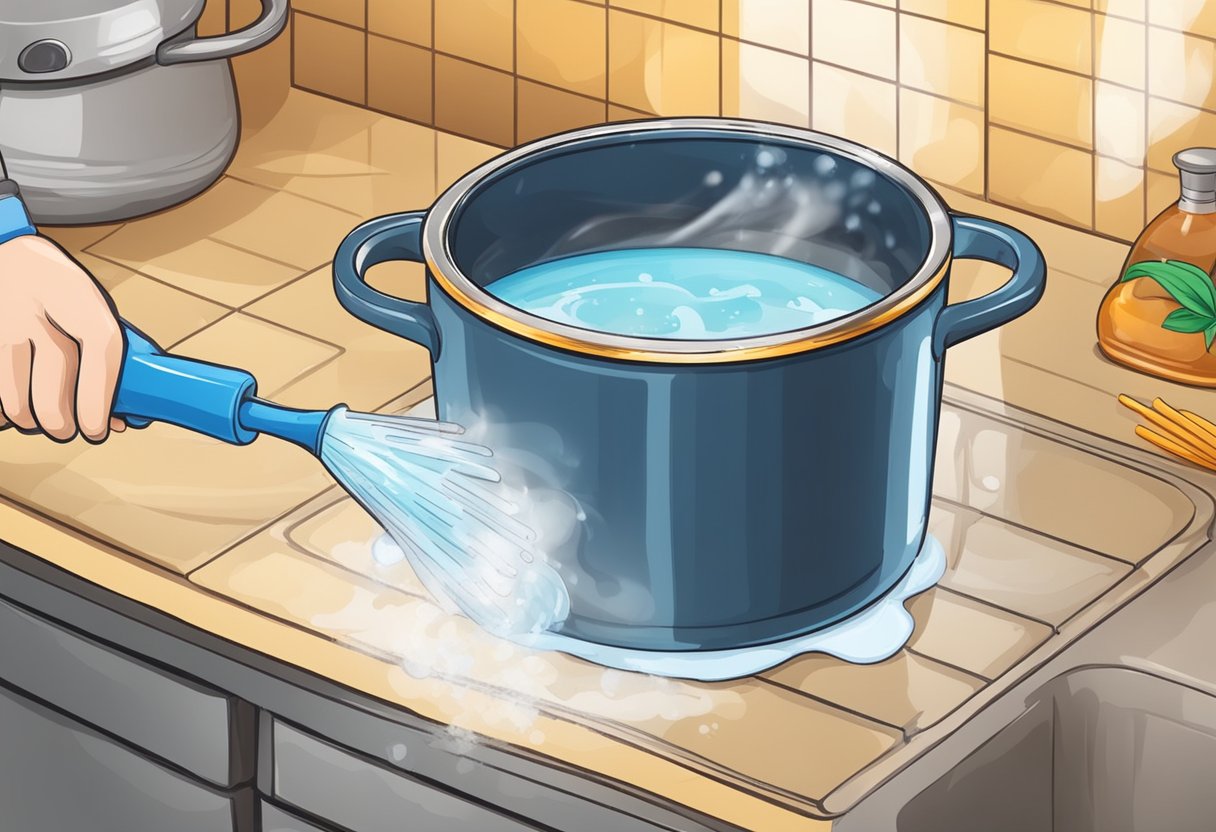
When it comes to cleaning a burnt pot or pan, you don’t always have to rely on harsh chemicals. There are many safe and natural alternatives that can effectively remove burnt-on food without damaging your cookware. Here are a few household ingredients that can get the job done:
Baking Soda
Baking soda is a versatile cleaning agent that can be used for a variety of tasks, including cleaning burnt pots and pans. To use baking soda, simply sprinkle a generous amount onto the burnt area, add a little water to make a paste, and let it sit for a few hours. Then, scrub the pot or pan with a non-abrasive sponge or brush and rinse with water.
Vinegar
Vinegar is another great natural cleaner that can be used to remove burnt-on food. To use vinegar, mix equal parts of water and white vinegar and bring the mixture to a boil in the pot or pan. Let it simmer for a few minutes, then remove from heat and let it cool. Once it’s cool, use a non-abrasive sponge or brush to scrub the pot or pan and rinse with water.
Lemon
Lemon is a natural acid that can help break down burnt-on food and remove stains. To use lemon, cut a lemon in half and rub the cut side over the burnt area. Let it sit for a few minutes, then scrub the pot or pan with a non-abrasive sponge or brush and rinse with water.
Salt
Salt is a gentle abrasive that can help remove burnt-on food without scratching your cookware. To use salt, sprinkle a generous amount onto the burnt area and add a little water to make a paste. Then, scrub the pot or pan with a non-abrasive sponge or brush and rinse with water.
Cream of Tartar
Cream of tartar is a natural acid that can help remove burnt-on food and stains. To use cream of tartar, mix a few tablespoons with enough water to make a paste and apply it to the burnt area. Let it sit for a few minutes, then scrub the pot or pan with a non-abrasive sponge or brush and rinse with water.
Citric Acid
Citric acid is a natural acid that can help break down burnt-on food and remove stains. To use citric acid, mix a few tablespoons with enough water to make a paste and apply it to the burnt area. Let it sit for a few minutes, then scrub the pot or pan with a non-abrasive sponge or brush and rinse with water.
Using these safe and natural alternatives can help you clean your burnt pots and pans without harsh chemicals. Plus, you’ll be doing your part to protect the environment and your health.
Dealing with Discoloration and Stains
https://www.youtube.com/watch?v=0FqPwe0x59k&embed=true
When it comes to cleaning a burnt pot or pan, dealing with discoloration and stains can be a challenge. However, with a few tips and tricks, you can get rid of those unsightly marks and restore your cookware to its former glory.
One effective way to deal with discoloration is to use a mild abrasive. Baking soda is a great option for this, as it is gentle enough to avoid damaging your cookware while still being effective at removing stubborn stains. Simply mix a small amount of baking soda with water to create a paste, then apply it to the discolored areas and scrub gently in a circular motion. Rinse with water and dry thoroughly.
Another option is to use cleaning products specifically designed for burnt pots and pans. These products often contain powerful degreasers and other ingredients that can help break down and remove tough stains. Just be sure to follow the instructions carefully and use gloves to protect your hands.
In some cases, you may need to soak your pot or pan overnight to loosen up stubborn stains. Fill the pot with hot water and a small amount of dish soap, then let it sit overnight. The next day, scrub gently with a sponge or brush and rinse thoroughly.
No matter which method you choose, be sure to avoid using harsh chemicals or abrasive materials that could damage your cookware. With a little patience and some elbow grease, you can get your burnt pot or pan looking like new again.
Conclusion
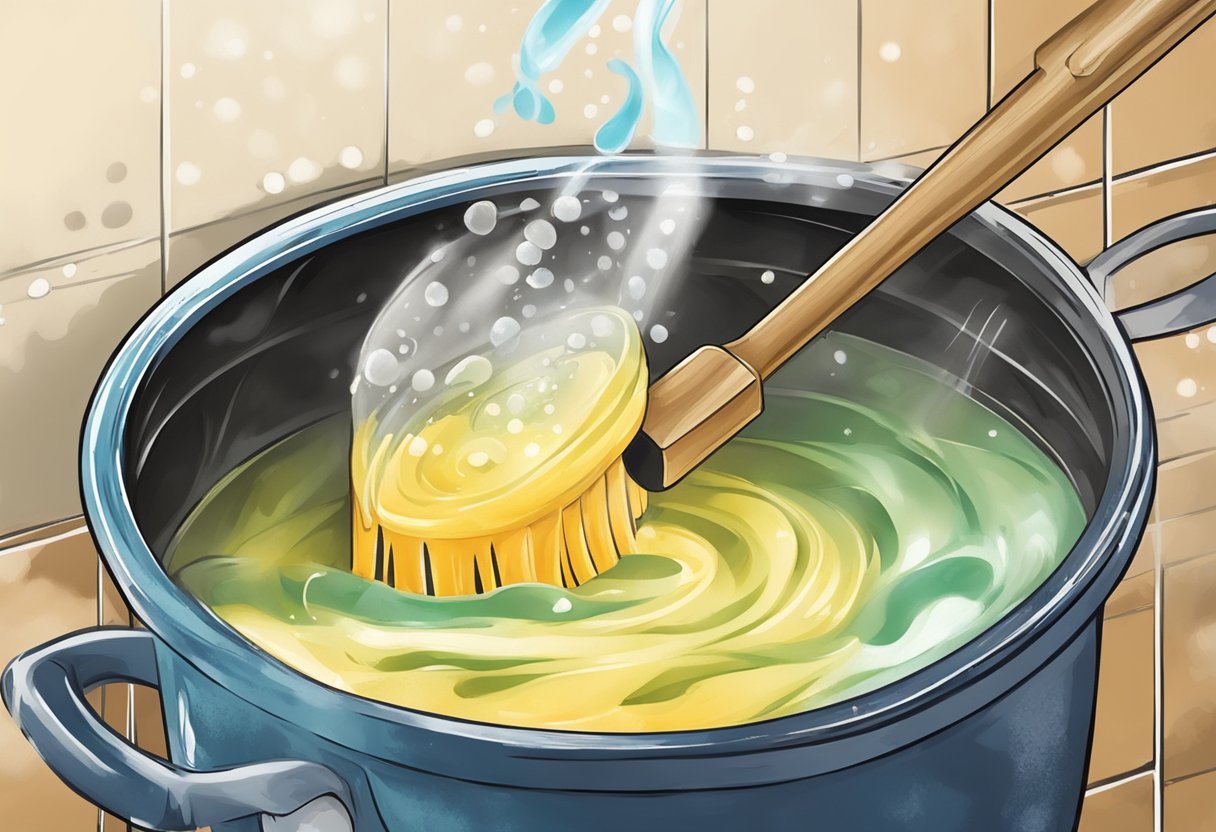
Cleaning a burnt pot or pan can be a daunting task, but with the right tools and techniques, it can be done easily. The first step is to assess the damage and determine the best cleaning method based on the type of pot or pan and the extent of the burn.
One of the most effective methods is to soak the pot or pan in warm soapy water for at least 30 minutes before scrubbing it with a non-abrasive sponge. For tougher stains, baking soda and aluminum foil can be used to create a paste that can be applied to the burnt area and scrubbed away with a ball of aluminum foil.
Another effective method is to use vinegar and baking soda. Simply mix equal parts of vinegar and water in the pot or pan and bring it to a boil. Then, add a tablespoon of baking soda and let it simmer for a few minutes before removing it from the heat and scrubbing it with a non-abrasive sponge.
It’s important to avoid using harsh chemicals or abrasive materials that can damage the pot or pan. Additionally, it’s a good idea to avoid using metal utensils that can scratch the surface of the pot or pan and make it more susceptible to burning.
By following these simple tips and techniques, you can easily clean a burnt pot or pan and restore it to its original condition. Remember to always take care of your cookware and clean it properly to ensure it lasts for years to come.
Frequently Asked Questions
https://www.youtube.com/watch?v=bi4qsB8dn4w&embed=true
How can I remove burnt food from a pot or pan?
To remove burnt food from a pot or pan, you can try using a mixture of baking soda and water. First, add a layer of water to cover the bottom of the pot or pan. Then, sprinkle a layer of baking soda over the burnt area. Let the mixture sit for a few hours, or overnight if possible. After that, use a scrubber or brush to scrub away the burnt food.
How do I clean a scorched pan?
To clean a scorched pan, you can try using a mixture of vinegar and water. First, add a layer of water to cover the bottom of the pan. Then, add a cup of vinegar to the water. Bring the mixture to a boil, and then remove the pan from the heat. Let the mixture sit for a few minutes, and then use a scrubber or brush to scrub away the scorched areas.
What is the best way to clean a burnt non-stick pan?
To clean a burnt non-stick pan, you can try using a mixture of dish soap and water. First, add a layer of water to cover the bottom of the pan. Then, add a few drops of dish soap to the water. Let the mixture sit for a few minutes, and then use a scrubber or brush to scrub away the burnt areas. Be gentle when scrubbing to avoid damaging the non-stick coating.
What household items can I use to clean a burnt pot?
You can use a variety of household items to clean a burnt pot, including baking soda, vinegar, dish soap, and lemon juice. Each of these items can be used alone or in combination with others to effectively clean a burnt pot.
How do I clean a badly burnt pot?
To clean a badly burnt pot, you can try using a mixture of baking soda and water. First, add a layer of water to cover the bottom of the pot. Then, add a few tablespoons of baking soda to the water. Let the mixture sit for a few hours, or overnight if possible. After that, use a scrubber or brush to scrub away the burnt areas.
Can salt be used to clean a burnt pan?
Yes, salt can be used to clean a burnt pan. To use salt, first add a layer of water to cover the bottom of the pan. Then, add a few tablespoons of salt to the water. Let the mixture sit for a few minutes, and then use a scrubber or brush to scrub away the burnt areas.
